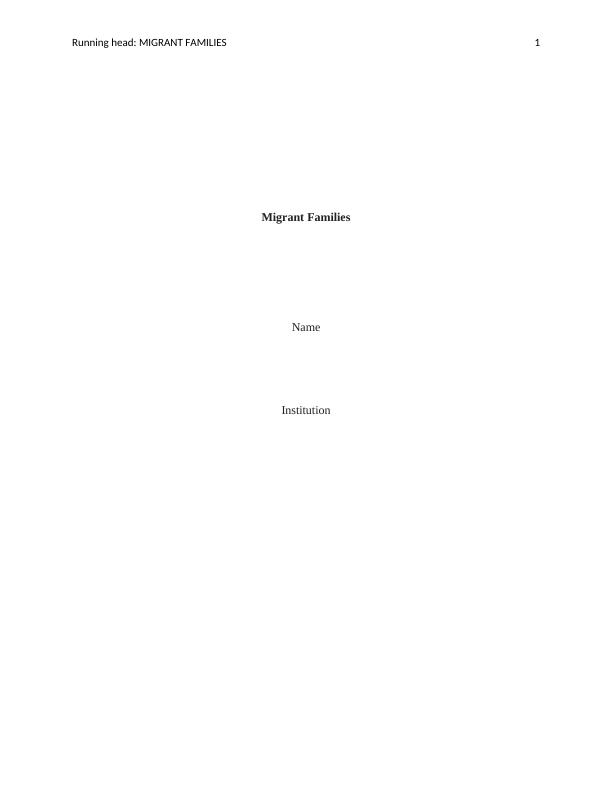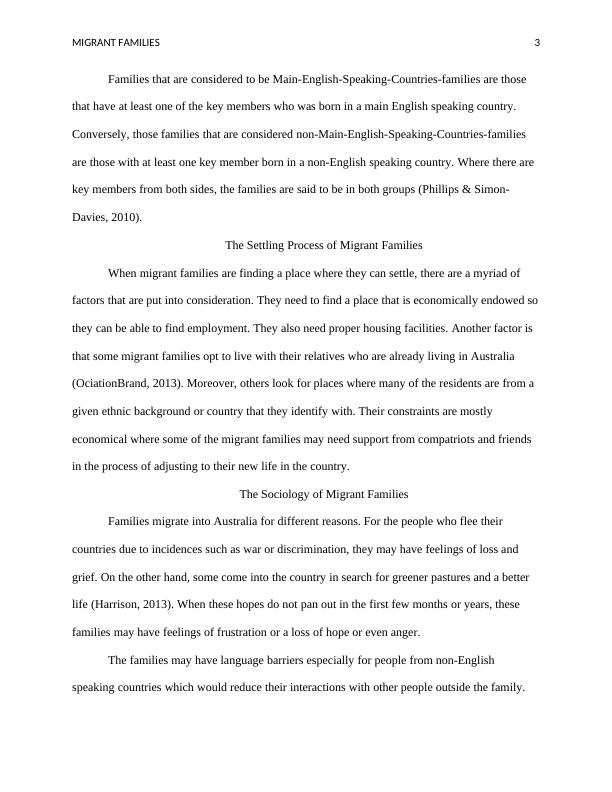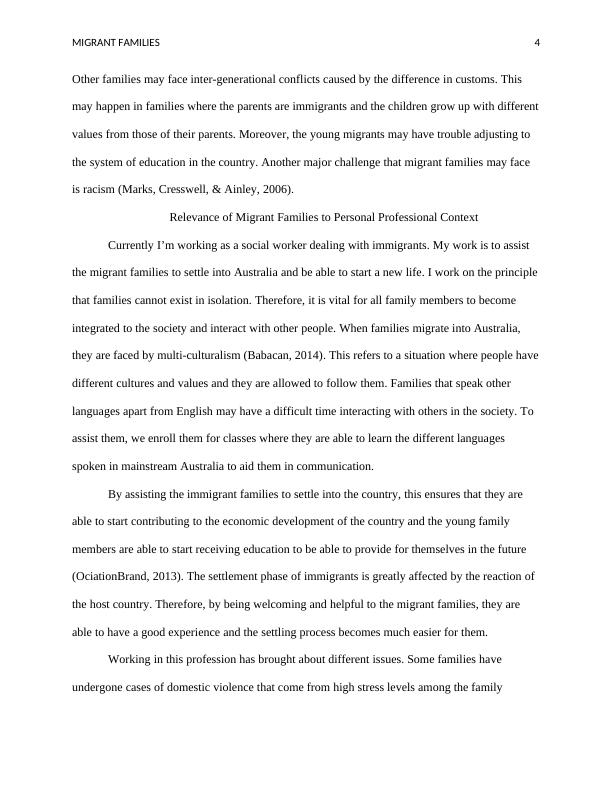A Census of Migrant Families in Australia
Added on 2020-04-07
12 Pages3352 Words469 Views
Running head: MIGRANT FAMILIES1Migrant FamiliesName Institution

MIGRANT FAMILIES2Migrant Families in AustraliaIntroduction Australia is a country that is culturally and linguistically diverse. In 2011, there was a census that was conducted which revealed that out of the total population of twenty-one million five hundred thousand Australians, at least a quarter of the total population was born overseas and migrated into the country at some point in their lives. An extra twenty percent of the total population is made up of people who have either or both of their parents being immigrants. Moreover, more than half of the entire population is made of people who are third generation Australians (Babacan, 2014). This migration has a great effect on the families. Of the people who migrate into Australia, some are single, couples, groups, or even family units. A survey showed that most of the migrant families were made of couples who did not have children. Over the years, migration of people into Australia has made the country a multicultural country. In the beginning, the majority of migrants came from North-West Europe and then more came in from the Eastern and Southern parts of Europe. In the last decade however, migrants from Europe into Australia have considerably reduced. On the other hand, there has been an influx of migrants from countries in Asia (Singh, 2016).In Australia, cultural and linguistic diversity is expressed based on whether one immigrated from a country that is English speaking or not. The major English speaking countrieswith immigrants in Australia include; the United Kingdom, New Zealand, the United States of America, Canada, and the Republic of Ireland (Vidal, Perales, Lersch, & Brandén, 2017). However, people who do not come from non-main English speaking countries are not necessarilybad at English.

MIGRANT FAMILIES3Families that are considered to be Main-English-Speaking-Countries-families are those that have at least one of the key members who was born in a main English speaking country. Conversely, those families that are considered non-Main-English-Speaking-Countries-families are those with at least one key member born in a non-English speaking country. Where there are key members from both sides, the families are said to be in both groups (Phillips & Simon-Davies, 2010). The Settling Process of Migrant FamiliesWhen migrant families are finding a place where they can settle, there are a myriad of factors that are put into consideration. They need to find a place that is economically endowed sothey can be able to find employment. They also need proper housing facilities. Another factor is that some migrant families opt to live with their relatives who are already living in Australia(OciationBrand, 2013). Moreover, others look for places where many of the residents are from a given ethnic background or country that they identify with. Their constraints are mostly economical where some of the migrant families may need support from compatriots and friends in the process of adjusting to their new life in the country.The Sociology of Migrant FamiliesFamilies migrate into Australia for different reasons. For the people who flee their countries due to incidences such as war or discrimination, they may have feelings of loss and grief. On the other hand, some come into the country in search for greener pastures and a better life (Harrison, 2013). When these hopes do not pan out in the first few months or years, these families may have feelings of frustration or a loss of hope or even anger.The families may have language barriers especially for people from non-English speaking countries which would reduce their interactions with other people outside the family.

MIGRANT FAMILIES4Other families may face inter-generational conflicts caused by the difference in customs. This may happen in families where the parents are immigrants and the children grow up with differentvalues from those of their parents. Moreover, the young migrants may have trouble adjusting to the system of education in the country. Another major challenge that migrant families may face is racism (Marks, Cresswell, & Ainley, 2006).Relevance of Migrant Families to Personal Professional ContextCurrently I’m working as a social worker dealing with immigrants. My work is to assist the migrant families to settle into Australia and be able to start a new life. I work on the principlethat families cannot exist in isolation. Therefore, it is vital for all family members to become integrated to the society and interact with other people. When families migrate into Australia, they are faced by multi-culturalism (Babacan, 2014). This refers to a situation where people havedifferent cultures and values and they are allowed to follow them. Families that speak other languages apart from English may have a difficult time interacting with others in the society. To assist them, we enroll them for classes where they are able to learn the different languages spoken in mainstream Australia to aid them in communication.By assisting the immigrant families to settle into the country, this ensures that they are able to start contributing to the economic development of the country and the young family members are able to start receiving education to be able to provide for themselves in the future(OciationBrand, 2013). The settlement phase of immigrants is greatly affected by the reaction of the host country. Therefore, by being welcoming and helpful to the migrant families, they are able to have a good experience and the settling process becomes much easier for them.Working in this profession has brought about different issues. Some families have undergone cases of domestic violence that come from high stress levels among the family

End of preview
Want to access all the pages? Upload your documents or become a member.
Related Documents
Diversity in Cultural and Linguistic Background- Australialg...
|10
|2331
|138
Population Needs Assessment for Afghan Migrants in Western Australialg...
|11
|3406
|232
Immigration to Canadalg...
|8
|1724
|31
English for Specific Purposes: Designing an Intensive Course for Refugee Families in Australialg...
|12
|2405
|213
Mental Health Issues in Immigrant Familieslg...
|9
|1919
|366
Population and Immigration Policies in Calgary - Deskliblg...
|10
|533
|80
